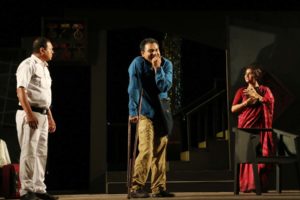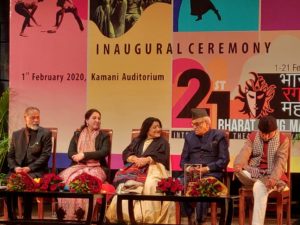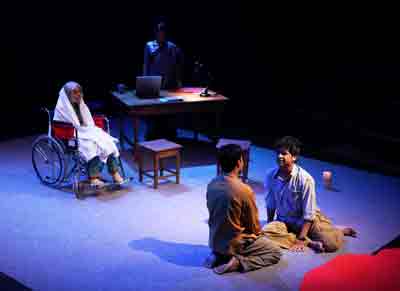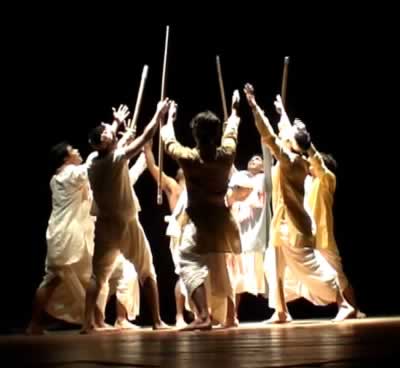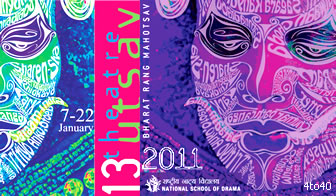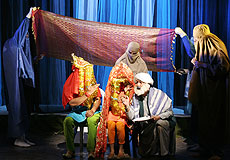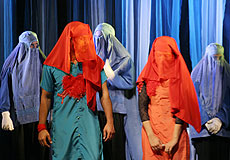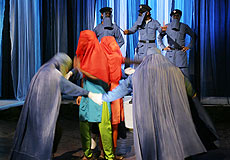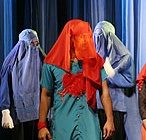FOLK THEATER
Folk Theater is a Theater which originated, evolved among and has been transmitted through the common people. Its relationship with the common people is deep, multiple and multi layered. It carries within it the entire culture with all its social religious institutions. We find reflection of customs, rituals and beliefs of common people. It aims at common man, the common man is emotionally and intellectually involved with this Theater, for him the Theater is not something external or superficial. It is part of his tradition with which he has lived for generations. Italio Calvino’s define folk Theater India Today: Folk Theater is “a work which persists as background noise even when a present that is totally incompatible with it holds sway”.
HISTORY
According to some historians, it was during the 15th and 16th century that folk Theater emerged in local dialects in different regions, and the themes it borrowed were Sanskrit epics and the Puranas, historical events, local folk tales of romance and bravery and biographical accounts of local heroes. The traditions of Indian folk Theater are not fully documented, for they stretch back into distant prehistory right from aboriginal cave dwellers who have left some record of their Theater in the form of wall and cave paintings. Even Buddhist and Vedic literature-works such as Arthashastra- tell art historians about rich traditions of Indian folk Theater. The classical and regional forms of Theater revolved around religion, legends and myths. There are indications of the impact of folk Theater even on the classical Sanskrit Theater. It thus became imperative to include Sanskrit Theater in this issue.
TYPES OF FOLK THEATER
- Jatra of Bengal
- Nautanki
- Ramlila of North India
- Raslila of North India
- Bhavai of Gujarat
- Tamasha of Maharashtra
- Terrakoothu of Tamilnadu
- Yakshagana of Karnataka
- Chhau of seraikella





MY CONTRIBUTION
I went to “Bharat Rang Mahotsav‟15” which takes place in National School of Drama. I attended few folk plays there and out of all the plays following are the two I liked most.
PANDWANI (DUSHASHAN VADH)

‘Pandwani’ is a form of play from Chhattisgarh. The Director of the play is Teejan Bai. It depicts the story of the Pandavas, the leading characters in the epic Mahabharata.
It is narrated in a very lively form. The lead artist narrated one episode after another from the epic in a very forceful manner. She enacted the characters in the scenes to produce a more realistic effect. Occasionally, she also breaks out into a dance movement. During the performance she even sang along the rhythm produced by the ektara held in his hand.
There are two styles of narration in Pandwani; ‘Vedamati’ and ‘Kapalik’. In the Vedamati style the lead artist narrates in a simple manner by sitting on the floor throughout the performance. The Kapalik style is livelier, where the narrator actually enacts the scenes and characters. Teejan Bai has been the most popular artist of the Kapalik style in the past five decades.
MADALYA
This form of play is from Gujarat the following three skits were performed. The very first script was on socio-economic aspects of the forest-based agrarian society. The tribes believed that the forest belonged to them and no- one else. Not even the government had any right over it. But British took control of the forest with the Forest Law of 1842, prohibiting the free usage of forest by natives. This skit was created in order to express the anger and protest against the law.
Another play performed was Sautish; Sautish in Dangi translates as ‘Sautan’ in Hindi or Polygamy. Polygamy was not socially accepted by a large part of the society. This skit in the most hilarious way portrayed the position of a husband with two wives. This universal story of a man with two women and their eternal quarrels remains the same for each society.
The last one was; Vagh-bokadi. It was quite common to encounter wild animals like tigers and bears in Dangs. Many a times they lost their cattle too. This skit refers to the everyday presence of wild animals in Dangi life and how they bump into these animals. Vaghdev was feared and yet worshipped. These contradictory emotions of love and fear are expressed in this skit. It is a comedy depicting an incident of a tiger eating the wandering goat of a careless Dangi farmer.
BHAVAI
Bhavai is the folk Theater of Gujarat, the homeland of Mahatma Gandhi. Backward inhibited the people are known for their shrewd business acumen. The rich and middle class are colorless. But the farmers, craftsmen, village artisans, poor and less inhibited bring color to their folk arts.
Gujarat state has two extremes. The upper class are prudish and preach and puritanism. The lower strata derive energy from the worship of Amba Mata, the Goddess of Power. The bhavai is performed during Navratri in form of shrine of Amba Mata. The players are convinced that the goddess attends the performance. That word bhavai has several interpretations. ‘Bhav’ means ‘life’ , ‘bhava’ means ‘sentiments’ and ‘vai’ means ‘carrier’ or a ‘diary’. So bhavai could mean “carrier of life” or “expressive of sentiment” or “diary of life”.

HISTORY
It was started in the early fifteenth century by Asita Thakur. A Brahmin of the Audichya Clan. He recited scriptures singing the texts and explaining their meaning to the devotees in the precincts of a temple in town of Sidhpur. An unusual incident turned Asatia into the originator of a new form of drama. Ganga beautiful daughter of the farmer of a neighbouring village was abducted by Muslim Chief. The villagers were infuriated, but no one dared challenge the Muslim Chief. Asaita Thakar went to him and pleased him with his singing. In return he asked him to set Ganga free, claiming that she is his daughter. The Chief knowing that Hindu orthodoxy did not allow a Brahmin to eat from the same plate as a farmer’s daughter put the poet singer to the test and asked him to eat with Ganga. Asaita ate and thus brought her back, but he was ostracized by his community. This turned him against Brahmins. He left with his three sons and decided to earn his living by singing and acting. He composed play let’s attacking social injustice, prudery and the caste system.
The three sons were boycotted by the society, their families were called ‘Trigala’. Today trigala is itself a caste and inheritor of Bhavai. The village headmen were grateful to Asaita and promised that in future village headmen would look after the needs of Asaita’s son and grandsons wherever they performed.
Asaita’s plays are an integral part of every troupe’s repertoire. A famous one is ‘Joothan Mian, others are Kajora, Chhail Batau etc.
In spite of the deep devotion of its players to the goddess, the bhavai is secular at its roots. Its jokes, dances, themes and songs deal with the life of common people. Mythological heroes are rare. It is the saucy maid, the miserly merchant, he betraying wife, the romantic stranger, the lascivious old man, the braggart,who regale the audiences.
PERFORMANCE
A Bhavai troupe consists of fourteen people, the Naik who is the director, stage manager and the leader of the party, who holds license to perform on other districts. The two male actors (Veshgor and Veshacharya) playing the hero and the secondary hero, the female actors (Kanchaliyas) of heroin and secondary heroine, the clown (Rangalo) and the instrumentalists. The troupe members are expected to observe celibacy for six months during performance time. Hindus generally believe that celibacy contributes to willpower and physical energy.
The Bhavai, like Tamasha is down to Earth. Women do not go to see it and this allows actors more freedom in vulgar jokes, abuses and off colour remarks. The women in Gujarat observe purdah an influence of century’s old Muslim rule and Hindu orthodoxy. She draws ghunghat across her face and looks through the fine muslin or silk as she talks. She speaks even to her husband behind the veil. Because of her purdah, men always take part of women in the Bhavai.
The lamp is placed on two bricks near the wall on which Amba Mata’s trishul (trident) is symbolically drawn with the white dots around it. The actors pass their hands over their eyes and foreheads to incorporate light. The sputtering lamp is the incarnation of Amba Mata. A symbol of power, it gives light and dispels darkness. The actors worship it. They put incense, fruits, camphor and coconut in front of it.
After putting on their makeup, the players sing a devotional song, garbi, invoking the goddess, and then walk to the arena, where the Naik draws a circle with a ten foot radius on the ground using the point of his sword. This is the acting area (paudh or chachar), sacred place only the performers can enter it. The actors and singers sitting in the paudh sing 5 devotional songs Then they rise and invoke the mother.
The instrumentalists are placed on one side. The Pakhawaj has a drum slung horizontally around his neck. The narghan player has a pair of small drums tied around his waist, and he plays them standing. One man jungles the sarangi, producing the subtlest undertones and overtones. The cymbal player adds metallic rhythm and clang. The most dramatic and unusual instrument is bhungal, a five foot long pipe with the tapering mouthpiece and a large bell shaped end. The bhungal folds up like a telescope. Its trumpet like sound is used for entries, exits and climaxes. The two bhungal players must have good breath control and stamina.
When the first invocation is sung, only the bhungal notes accompany it. No drum or cymbal is allowed. No one dances. Everyone is in meditation. During the invocation all the players are in paudh. The actors who are part of subsequent scene suddenly disappear. The actors slip into the dressing room in turn as their cues approach. Other actors are part of chorus. Every one of them can sing and dance and can play an instrument.
After this God Ganesha is invoked. The actor playing role of Ganesha wears ankle bells, a yellow silk dhoti, a silk jacket, garlands, and a cap. He holds a shining brass plate and moves it horizontally and vertically before his plate. The brass plate is there to hide his face since no one is expected to impersonate Ganesha.
When the prayer to Ganesha is over, The village barber walks through the passage carrying a big brass torch. In olden times the torch was invariably of silver if the Bhavai troupe was prosperous. When an important character is to strike a pose, the barber promptly rushes to him with his flaming torch and moves along with him, highlighting his facial expressions.
The performance starts about 9 in the evening and continues until eleven in the following morning. A sequence of dialogue completing a thought process or an incident is marked by a brisk dance phrase. The Naik speaks out the drum syllables: tata-thai thai, tata-thai thai, tata thai ta. The characters dance to the rhythmic syllables which are repeated three times. This breaks the monotony of the spoken word and stitches together the rambling dialogue.
COSTUME, MAKUP and PROPS
Each character carries his own costume and does his own make up. The colours mostly used in makeup are white, red and black.
The characters of humbler social status like a barber, a farmer, a merchant, a scavenger or a gardener do not use any makeup or period costumes. Kings and Chiefs have exaggerated moustaches, eyebrows and a faint reddish paint over their face. A king’s costume is a mixture of the Mughal and the local Gujarati folk style. The tunic is tight at the waist and flares below. The pyjamas are narrow at the claves. and bulge at the thighs.
The Brahmin is dressed in a thin, red bordered white dhoti. The sacred thread (janiyau) runs from his left shoulder across his bare chest down to his waist at the right. On his forehead three lines of sandalwood paste with two crimson spots in the centre. Wearing a tilted cap on his close shaven head, he carries a brass jug in his head and scriptures under his arm.
The actors have very few costume changes. The same actors may play different characters. By tilting their turban, changing his gait, changing position of the scarf etc.
MADALYA
Another folk form of Gujarat. The term Madalya is derived from Madal, a large tribal percussion instrument, similar to dhol. Madalya plays central role in the play. This form is thus named after it.
The body language, gestures as well as movements of the body are self- expressive. The imaginative use of makeup is really impressive.
HISTORY
The Dangi is a small district located in southern Gujarat. It shares more than 50% of the border with Maharashtra and this has influenced its culture and language a lot. Dangi is a tiny forest area. However from 1818 onwards, it came under the British. The British had realised importance of its rich forests of teak and bamboo and wanted to exploit these. Until this arrival the dangs were divided under four rulers of the tribe of Bhils, the original inhabitants of this area.
In order to own the forests, British struck a deal with these kings. They were given a meagre ‘privy purses’ in exchange for the ownership of the forests. The property rights of the forests were transferred to the Indian Government after Independence.
The transfer of forests did not affect Dangi’s much at first. But later on the restrictions imposed by the British authorities and subsequently by the Indian Government too, brought it home to them that they no longer had any rights on the forest produce. This irritated the Dangis. These tribes indulged in their traditional habits of cutting the trees etc. This seemed to flout the ‘rights’ and ‘laws’ of authorities, who then beat them, punished them and even jailed them at times. They were doing what they had been doing for centuries. But that was no longer legal and so the chastisements. This disrupted their understanding and they could not reconcile to the new phase of life. This led to irritation and resentment against these restrictions, for these affected their sources of income adversely too. It was the forest department which was earning profit from the forest produce instead of them, and they turned into mere labours for the forest department.
The Bhils felt displaced and alienated in their own land. Their anger and frustration, resentment and protestations found expression in Theater. The Madalya form proved a proper medium for airing their helplessness and resentment against the new set-up. It has an innate strength of expressions and can communicate their innermost feelings, thoughts using humour and laughter to bring the message to fore.
This form has the capacity to advocate the social changes needed in their own society by exposing its evil practices. Several skits reveal the major characteristics of the socioeconomic life of the Dangis as it used to be and how it was jeopardized. Madalya form of Theater acted as a ‘safety value’ to let off their steam of frustration and resentment which otherwise could have resulted in open rebellion.
PERFORMANCE
Madalya is a night long affair. It is performed from late evening to nearly early morning. The audience surrounds the performing area and the actors face in all the directions. In an open plot, the vesh is performed with lightning provided by the petromax lamps or torches or electricity if available.
A Madalya team belongs to a village and is named after that village. The performers are usually numbered between 14 and 20 with 4-6 Madal players, 2-3 Gamars (lead singers), 5-7 Chorus singers, 1-2 Sohangis one Rambha Patra (female character) and one Sutradhar or Patil. Four to six huge Madal drums are used simultaneously in Madalya. The performance is inaugrated by the Madal players, The singers stand in either a straight line or in a semi-circle. They open the performance by Naman Geet, a kind of prayer to Ramdev, Mahadev, Krishna’s Dwarka, Unaidevi, Pandavas etc. The Madal drum players give the beats and also dance in rhythm in a linear or circular movement. The movement patterns are of seven types and these are selected according to the skit. Madal has to be played in a particular taal. There are three basic taals Thirsya, Dobing and Madal. The Thirsya taal is used at the times of marriages and is similar to Dadra Taal of Indian music. Dobing taal is used when the Madalis are playing the drum and dancing. The Madal Taal is most frequently used like when the performance begins.
The lead singer or singers (Ganar) sing the songs and the chorus repeat the lines together, The song gives a brief idea of what is to follow in the next phase of performance or another skit that would be coming up.
One can recognize this Theater form not only by the madal drum but also some typical arrangements of characters in them. The common characters are Sohangi (Vidushak or the fool), Gandey Natwa ( Sutradhar or Patil) and Rambha Patra (female character) played by men only.
COSTUMES, MAKEUP and PROPS
It is interesting to note the costumes and makeup in this character, as they are prominent by their simplicity and sometimes totally without any special provision. Sohangai wears only a loincloth, the usual dress of Dangi. Others may wear pants and shirts. Patil wears a shirt and dhoti along with a cap to show his power. The Rambha Patra wears a saree and blouse, sometimes jewellery too and always covers his head with the loose end of the saree.
Make-up is also minimal and used only to heighten expressions . the usual theatrical make-up is not used at all. Some sohangis paint their chest and face with soot and lamp black. A beard made of string of jute is used to indicate old man, old woman. Dark glasses, tiger masks, artificial moustaches are used to and when needed in a skit.
Kudkas is an instrument to indicate the power of the Patil who uses to hit the Sohangi for his pranks throughout the vesh. Other props are adapted from whatever material is at the hand. Even human bodies are made use of. For example, they substitute logs by rolling human bodies or men arrange themselves in such a fashion that we can see a stone wall made of them.
CLASSIFICATION
Madalya Vesh can be classified based on the themes into
- Social
- Nature- Related
- Protest
- Occupational
The Social Skits deal with the problems of their own community. These are full of humour and laughter even when sarcastic. Popular social skits are Be Bairi no vesh ( Tale of two wives) and Pahana (Guest) Environment being an integral part of their lives, it is seen in their vesh too. For instance, in Wagh Bakdi , The goat of Sohangi is eaten up by a tiger in the forest. Such incidents are common in their lives. This experience was converted into comedy of errors. It is a popular skit.
Rebellion against authorities is strongly expressed. When the tribals lost control over their forests, the restrictions imposed by the authorities were resented by the Dangis and they voiced their protest through Theater.
Some themes are even related to special occupations that are connected with environmental needs such as hunting, castration of oxen, grazing cattle, goats in the jungle The occupational hazards the face are also shown in a way that generates laughter in the audience.
There are few skits that are both related to occupation and nature. For instance, skits of Harpin and Murain revolve around female characters that have to go into the jungle due to their occupation or duty.
Undoubtedly, Madalya Theater provides interesting entertainment and voices the feelings of Dangis very well. But it’s not that popular now. Modern sources of entertainment such as television, radio and films make Theater no longer thrilling or enjoyable. A small number of scripts repeated over time, also lose power to entertain the new generation of Dangis. Especially when no new skits are coming forth. It is an all-night affair but now-a-days people prefer spending their night time with television.
Even the visual attraction is lacking in this Theater. as their costumes remained simple. It does not have mythological or epic stories that find acceptance even in the modern times. The artists so not have a good income from their performances, this also discourages the new generation from joining the team of their village and continuing the art. The advent of other forms like Tamasha from Maharashtra, diminished the popularity of Maharashtra. The music of Tamasha is based on Hindi films which attracts large crowd.
Utpala Desai has written in Horizon’03 “ In spite of such a strong capacity and structure, this form of Theater has not received the attention it deserves. If taken seriously it can be a competition to even modern Indian Theater. I think because it makes no little use of props. It lets imagination run riot and achieves easily aim of all performing arts where the audience feels one with the performers. It is high time that we study this form and develop it so that it receives acceptance and gives us an opportunity explore another form of folk entertainment. Instead of treating it as a museum piece, it should be brought to life with new techniques and themes of current interest and shouldn’t be left to die, as we have done with so many other inherited art forms.”
TRADITIONAL THEATER OF INDIA – CONTINUITY AND CHANGE
It is believed that Theater and drama are gift of west to India. We have some popular entertainments like Nautanki or the Jatra but these had little to do with drama which was introduced by British. Indian Drama is more of dramatic poetry even that had become extinct and was rediscovered for India by the western scholars. Nothing could be further more truth.
The distinctiveness of Indian Theater tradition in the dramatic cultures of the world- its antiquity as well as its imaginative and aesthetic quality is more or less indisputable today. The roots of Theater in our country are very old and deep. It had undergone wide ranging, fundamental changes during the last two to three thousand years.
It can be safely asserted that some kind of theatrical activity with elements of music, dance, acting had been in vogue in the country for at least a thousand years before the Christian era. With the appearance of more favourable socio- cultural conditions, it gradually acquired more regular and complex forms, such as those of Sanskrit drama and Theater from sixth to fourth century B.C. Thus began that fascinating period of the unique flowering and achievements of the Indian dramatic tradition.
In this new phase plays of different kinds, styles and artistic excellence were written in Sanskrit, the language of literary expressions of that time. Many innovative and often highly sophisticated styles for the presentation of those plays were also developed. This burst of energy was not confined to creative exploration dramatic writing and staging.
But this Theater, established on such a strong base of theory and practice had disintegrated gradually by 10th century A.D. There are many reasons for this decline: social and political instability created by foreign invasion and internal conflicts, loss of creative energy in the Sanskrit language gradually confined to a small elite, fall in the standard of dramatic writing due to lack of talent, loss of appeal for common spectators too. And this Theater gave way to another Theater tradition that flowered in different regions of India.
We thus came to the next phase of Indian Theater which took place not in Sanskrit but in different regional languages carrying with the distinct social, cultural, literary milieu and flavour of each region. This phase of Indian Theater is spread over a period of about one thousand years, and many of its strands and forms have continued up to the present day. The activity in this entire phase is often called ‘folk Theater’ today, because unlike the town based classical Sanskrit Theater it has flourished in the countryside.
A FEMINIST PERSPECTIVE
If one were to look for a gender identity for theatrical forms, then clearly folk Theater would be feminine as against the masculine classical form. As Rubees observes, “a feminist dramaturgical aesthetic spurns these structures based on conflict and resolution. Where everything gets built up to one screaming point and then everything is released. Women often write in waves, repeated climaxes, collages..”
Despite the ongoing efforts of groups of women in India to Indianize the feminist movement, the popular conception of the term Feminism remains both ignorant and imitative. Sociological studies outline a movement that is at best skeletal, too amorphous and rambling to have any meaningful impact in any but a sporadic way. Most importantly, the reach of feminism is restricted to an urban upper class. India‟s urban rural divide intensifies the problem of disparity between women of varied socio economic backgrounds, problematized further by the aspect of caste. Women‟s class „economic grounding, family and geographical locations‟ have a direct bearing on their intellectual leanings. Work is not a common yardstick of liberation for urban and rural sisters. For a woman belonging to the elite class, a job spells economic independence and therefore liberation while for rural women belonging to the lower classes; work is a reminder of their economic bondage. Gender in their context is not a distinguishing factor since both sexes have an economic responsibility to fulfil. The status and position of women within the Indian patriarchal system however, leaves a lot to be desired. If Indian society is to become truly modern and progressive, the concept of equal rights and awareness of social realities must reach all women but particularly rural women who are the most exploited. For the feminist quest, folk Theater displays an almost natural propensity. When compared, the features of the sub genres of folk Theater and feminist Theater (as it exists in the West) divulge a large number of similarities in both form and structure. The parallels between folk Theater and the feminist quest are undeniable. Balwant Gargi in Folk Theater of India listed out certain characteristics of folk Theater. He stated that some precepts of folk Theater remain common, regardless of state and cultural identity. Primarily rural, it is rustic, unselfconscious, spontaneous and boisterously naïve. Folk Theater does not offer a slice of life, but a panoramic view of existence and elicits enthusiastic audience participation.
Ann Saddlemayer, eminent feminist critic, says of Feminist Theater, “that‟s how our art should be all encompassing, sucking in, surrounding, embracing, not linear, not clear cut, not sequential…film, slides, music, puppets actresses, dancers, everywhere on top of you., below you, around you. That would be women‟s Theater•a circus feeling throughout the play, a circus that people could enter. Ideologically then, there is a definite match but structurally too, similarities between folk Theater and feminist Theater are too many to ignore. Both defy the linearity of time and space favored by classical (male) Theater, in an effort to achieve timelessness. Both refrain from the concept of linear time and may build up a montage of varied dramatic episodes. Because both are performed by the marginalized, there might be a paucity of funds, so the same set is often transformed via word or action. Props are also minimal. Furthermore, the actor/character is chameleon•like. One actor sometimes plays several roles. The feminist protagonist plays several roles to heighten the sense of female perspective of various incidents. Feminist Theater by definition is drama that embraces transformation, inspires and asserts the possibility for change. Its emphasis on role playing implies that we (human beings) are what we do and what we become and that no one, neither man nor woman, is restricted from becoming the other.
REFERENCES
Folk Theater of India by Balwant Gargi
Horizon Magazine-Issues of Folk Theater (Guest Editor: Manohar Khushalani) http://www.gujaratindia.com/about-gujarat/bhavai-folks-drama.htm http://www.demotix.com/news/2473065/tribals-rehearse-ahead-national- folk-theater-festival#media-2473014
